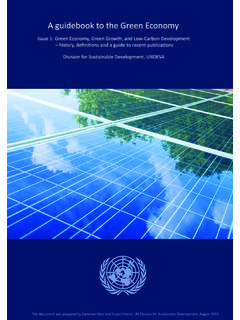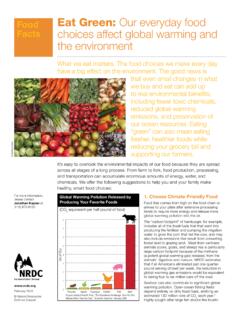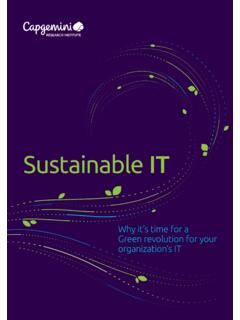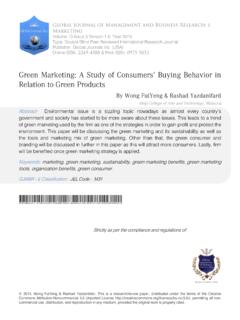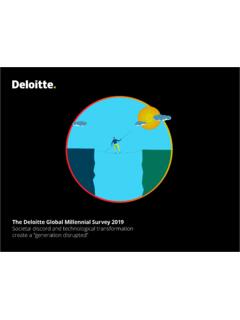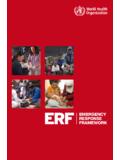Transcription of INTRODUCTION TO GREEN FINANCE - Global Environment …
1 INTRODUCTION TO GREEN FINANCEAn estimated $400-600 billion per annum is needed to FINANCE conservation of land, forests and water, and more than $350 billion of incremental capital to fund projects in renewable energy and energy efficiency. Today, less than 15% of required capital flows to conservation, the bulk of it coming from public and philanthropic entities. The latest accounting of climate FINANCE shows there is a financial gap of about $70 billion. It is thus important to understand the ways we can leverage additional resources to preserve healthy ecosystems on land and in the brochure aims to provide a short explanation of GREEN FINANCE to readers outside of the FINANCE space. There is an abundance of literature on GREEN FINANCE , the role and importance of public and private sectors, and a variety of instruments deployed.
2 However, much of this information is aimed at experts. As a result, there is a growing need for simpler material to help a broader audience and even environmental professionals to understand and navigate this space. The brochure also shows how the Global Environment Facility (GEF), with its limited resources, can leverage private sector investments through grants and non-grant instruments. The public sector plays a critical role in climate FINANCE . It provides grants for policy reforms and serves as a catalyst to leverage private FINANCE at scale. The private sector is also crucial since it is a potentially large source of funds for environmental projects. The GEF, being the largest public funder of projects to improve the Global Environment , has involved the private sector in its activities for well over two decades.
3 INTRODUCTION TO GREEN FINANCE INSTRUMENTSThe predominant financial instruments in GREEN FINANCE are debt and equity. Financial instruments have several features, such as level of seniority (junior equity versus preferred stock), the channel through which the flow of FINANCE is arranged and the intermediary actors (types of investors and investment vehicles), terms of the agreement and origin of funds among others. This brochure focuses on those related to debt and equity, as well as risk management product - a guaranteeEquity financing, often used in the early stages of developing a project or company, is the method of investing capital in a company stock in return for an ownership interest. Equity, also called stock or shares, can be split into preferred stock and common stock.
4 There are two major distinctions between the types of shares. If a company must liquidate and pay all creditors and bondholders, preferred shareholders are paid first. If any money is left, common stockholders will receive their payments. Second, the dividends of preferred stocks are different from and generally greater than those of common stock. In GREEN FINANCE , we often see investments in junior equity , which normally refers to the common stock in a company. In the event of liquidation, the company would pay out preferred stockholders before holders of junior equity. On the other hand, holders of company bonds are paid before holders of preferred stock. The GEF invests money in junior equity to absorb some of the risk for other (private) equity investors.
5 Essentially, when they see investments in junior equity, other equity investors are attracted to purchase preferred stock. This ensures they have first claim on distribution of profit and reduces their financing is typically used at later stages of development and often in combination with equity. In debt financing, investors lend money to borrowers, who pay back this amount (the principal) with interest under For more information on debt and equity instruments, their main features and use in climate financing, see UNEP (2014) Demystifying Private Climate to GREEN FINANCE 1strict conditions. If a company liquidates its assets, debt has higher priority than, or is senior to, equity. In other words, a company must meet its obligations to creditors (those who lent the money) before it pays those who borrowed money to invest in equity.
6 As a result, more senior debt has a greater level of security, which allows for a lower interest payment than more junior security (also known as subordinated debt).Debt financing can come from a lender s loan or from selling bonds to the public. While a loan is a transfer of money from a bank to a company/individual, a bond is a transfer of money from the public/market to a company that issues a bond. Unlike loans provided through bank debt, bonds traded on public debt markets tend to involve larger amounts of capital (typically US$100 million and above) and are open to the general public for investments. Bonds in the GREEN FINANCE field have been targeted more at qualified investors. However, certain types of notes ( promissory or structured notes) have also been made accessible and affordable to retail investors because they require less upfront investment.
7 How much debt, and how much equity is right for a project or a company, varies by industry. Fast-growth fields with potential for high returns, such as software and biotech, attract equity investors more easily. Those companies also often have intangible assets and uncertain cash flow. This makes it difficult to forecast debt repayment schedules and conditions. As a result, they are often unable to borrow at workable rates. Debt investments typically involve less risk than equity investments. Consequently, they also typically offer a lower potential return on and equity funds are investment vehicles of choice in environmentally related FINANCE . This is because they enable project and cash flow to aggregate into one common investment vehicle.
8 This vehicle combines several projects that may have a different focus, such as land use, forestry and agriculture. Whatever their focus, they have the same level of maturity (either early stage development, proven concept or mature). However, they use distinct scaling and risk mitigation strategies. Finally, funds typically allow for risk diversification among projects/investments. Mainstream investors are usually more familiar with their structure, and thus more comfortable investing in them. Investors often manage risk using loan/credit guarantees from public FINANCE institutions that protect them against defaults on their loans. This instrument transfers part or all of the risk from the lender onto the public institution (loan guarantor).
9 In this way, the lender can charge a private investor a lower interest rate on the loan, thereby lowering its cost of capital and increasing its profitability. Similar to guarantees, other risk management tools are used to leverage debt or equity investments. Public institutions can insure private investors against risks arising from policy uncertainty. Foreign exchange liquidity facilities can help reduce the risks associated with borrowing money in a different currency. They do this by creating a line of credit, which the project can draw upon when it needs money. It repays the credit when the project has a financial surplus due to currency more information on typical GREEN FINANCE vehicles, see UNEP (2014) Demystifying Private Climate FINANCE Credit Suisse Group AG and McKinsey Center for Business and Environment (2016) Conservation FINANCE .
10 From Niche to Mainstream: The Building of an Institutional Asset more information on public tools to leverage debt and equity investments, see Overseas Development Institute (2011) Back-ground Note: Leveraging Private Investment: the Role of Public Sector Climate INTRODUCTION to GREEN FinanceLEVERAGING PRIVATE FINANCE The growth of GREEN FINANCE markets represents an emerging opportunity for both the private sector investment and project developers. Filling this gap to FINANCE the preservation of the world s precious ecosystems will require billions of dollars in additional capital, and private investment capital may be the main source of such funds. This highlights the need for intelligent development FINANCE that goes well beyond filling financial gaps and that can be used strategically to leverage private resources.


